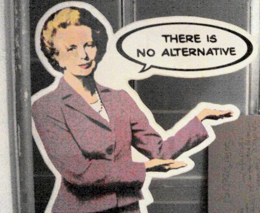BY: NICOLE RITCHIE
A major tenet in queer theory is its disavowal of neoliberalism. These criticisms have been elucidated through the creation and utilization of various terms, such as
heteronormativity,
homonormativity, and
homonationalism. However, what even is neoliberalism?
David Harvey is an oft-quoted author of this concept from his book entitled
A Brief History of Neoliberalism (2005). While giving a useful history of the development and pervasive adoption of neoliberalism on the world stage, Harvey is very clearly critical of the economic political system. I can in no way relay the complexities of this system’s development, but, instead, with this post I want to set an initial seed for considering neoliberalism in relation to the museum.
On the most basic level, “neoliberalization has meant, in short, the financialization of everything” (Harvey 33).
 |
| Meme of Margaret Thatcher, a major figure in the 1980s growth of Neoliberalism; her infamous slogan was TINA: there is no alternative |
“Neoliberalism is in the first instance a theory of political economic practices that proposes that human well-being can best be advanced by liberating individual entrepreneurial freedoms and skills within an institutional framework characterized by strong private property rights, free markets, and free trade. The role of the state is to create and preserve an institutional framework appropriate to such practices” (Harvey 2).
Furthermore, neoliberalism strategically chose the seductive ideals of human dignity and individual freedom as core values, which were also, not accidentally, counter to views of fascism/dictatorships/communism that conversely utilize collective judgment versus individual free choice (Harvey 5). Harvey highlights how this concept of ‘freedom’ is utilized to justify all things, for American neoliberalism in particular (39). Success, in opposition to failure, is placed diametrically in relation to personal and cultural pursuits, rendering inequality as a necessary risk of enabling the rights and liberties of the individual. Queer and affect theory has delved into this language and tool of individual rights and the ‘right’ pursuits, which, as mentioned in the terminology links above, are of course limited within this – something I will be engaging with soon.
“To live under neoliberalism also means to accept or submit to that bundle of rights necessary for capital accumulation. We live, therefore, in a society in which the inalienable rights of individuals…to private property and the profit rate trump any other conception of inalienable rights” (Harvey 181).
 |
| Meme of David Harvey |
I came across an intriguing museological happening when considering the ‘neoliberalization of culture’ that I think would be valuable to discuss within our museum studies community prior to fully operationalizing what this concept (that is, the ‘neoliberalization of culture’) entails within the literature.
Students in London, UK occupied the empty School of African and Oriental Studies' property on Gordon Square, renaming it The Bloomsbury Social Centre in 2011 and creating their “Museum of Neoliberalism”. The exhibit space contained empty glass cases, containing only artefact labels of ‘Culture’, ‘Politics’, and ‘Economy’.
 |
| Image of the Museum of Neoliberalism |
As discussed in
one article, this attendee highlights some important considerations about what this emptiness symbolizes:
“The exhibit of nothing (with the exception of a lone Lehmann Brothers’ cap in one corner) suggests multiple meanings: is it empty because neoliberalism has so pervaded every aspect of our lives that in our contemporary moment we have indeed “forgotten” the most pernicious form of capitalism yet witnessed by the world? Is it empty because at some future point the ascendance of neoliberalism will mean the “absolute hollowing out of culture, politics and the state” as one commentator suggests—or, even more so, that neoliberalism will have entirely eviscerated our capacities to imagine what the terms “politics” and “culture” even mean, let alone identify objects associated with them? Does the ex post facto request for visitor participation point, ironically, to the “degree of respect” with which neoliberalism cares about public input?”
This questioning of ‘full or empty’ is further contextualized and interrogated
here by another attendee of the event.
What do you think of this ‘museum of neoliberalism’? How does it speak in dialogue with the political economy of our time and the museological work that we study and practice? What does this exhibit say about the ‘neoliberalization of culture’?












